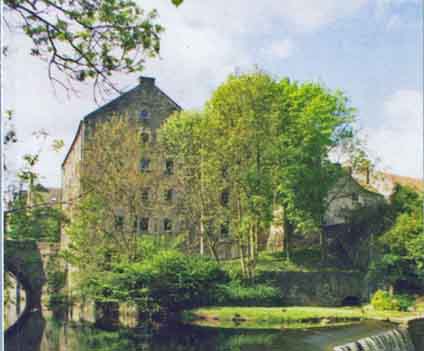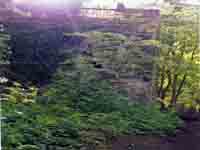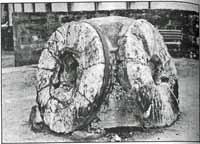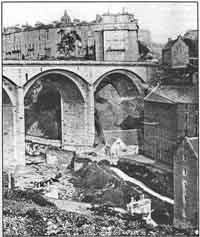The Dean Mills
The grain mills clustered on both sides of the river were the bread basket of Edinburgh and were run by the Incorporation of Baxters, the oldest and strongest of the city's Trade Guilds. In the 17th century there were 11 mills, each with it's own girnal (granary) alongside.
'There are two high weirs. The upstream one (which now has new housing beside it and a metal stair almost above it!) powered mills on the north side of the river and the lower one powered those on the south side. Most of those on the north side, said to number eight, were swept away to make Legate's skin works in 1843 leaving just the lowest pair. the West mills (present form 1805).
West Mills; Wheatsheaf in circular panel in gable dates 1805 and 1896 and names of its owners of that time. (This is the southern
mill). In the 1850s the West mills had a powerful wheel each and the paired ports by which the water returned to the river are visible on
the river side of the southern mill and the downstream side of the northern one (where one has been bricked up)
The picture shows the northern pair are to the right of the small lawn when you face West mill from Millar row.

West Mills
Immediately below West mills is the lower weir some 12 ft high. This fed three mills in succession - Lindsay's (1556) being virtually at the end of the weir, then Mar's then Greenland beyond the arches of the Dean Bridge. In the 1850s these mills had one wheel each.
There is a motif of crossed peels and the date 1643 by the post at end of Millar Row beside the bridge and the weir. Beside it is a lintel with inscription "Blesit be to god for all his gifts". This was once part of the gable of Lindsay's mill.
The lower part of Lindsay's mill, best seen from the riverside below the weir (gate to east of millstones) survived demolition in
1937 and, on what must have been the second of its original five storeys, three French millstones are arranged, leaning together to display their
grinding surfaces. A proposal in 1996 to renovate Lindsay's mill failed to win the support of the local residents.

Lindsay's Mill
Soft grains like oats and barley, peas and beans could be milled using gritstones of the type produced in Derbyshire and Yorkshire hence the name 'millstone grit' for the rock, but similar stones were also produced locally at Hailes Quarry. However wheat required a harder, finer stone and the Dean stones are examples of French Burr stones, composite quartz stones imported from Normandy. Pieces of stone were shaped to fit together, cemented with plaster of Paris, and bound together with an iron rim. Such stones were twice as expensive as gritstones. The dressings, the distinctive pattern of grooves cut into the flat surface of the stones, are still just discernable on the stones at Dean. Oddly the stone facing the river seems to show traces of an unusual spiral dressing while the other two have the common dressing of parallel grooves in tangential segments.

Lindsay's Millstones
The old photo shows part of Dean bridge (c1880?) and Mar's mill with its wheelhouse jutting out across the Great Lade. Next to it is the Jericho girnal. The Lade went round the bridge pier to serve the Greenland mill, of which nothing but gateposts remain.
The lade was removed in around 1890 after complaints about its insanitary state. The only trace of it now is the blocked up arch beneath the south end of St Bernard's bridge. (Where the bridge joins the road, not the south bank!
Mar's mill disappeared in the late 19th century and other buildings including Lindsay's mill and a number of cottages went in the 1930s and 50s so the gaunt close built character of this bank was lost. At the east end close by Deans bridge the early 20th Cent. building with a crenellated top was once a squash court and then a factory.

Mar's Mill about 1880